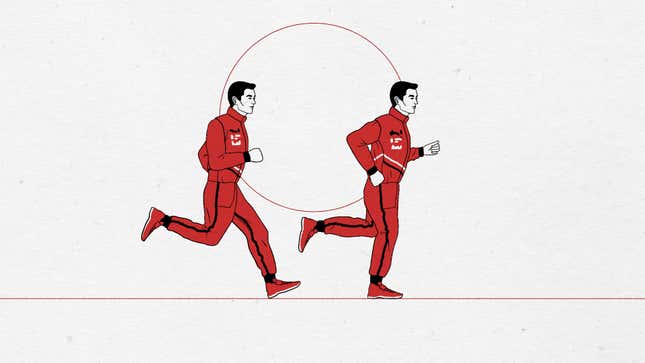The 24 Hours of Le Mans may be one grueling day of racing every year, but preparing one’s body and mind to compete in it is a year-round, full-time job for the drivers who tackle it. Earl Bamber, who raced a GTE Pro-class 911 RSR for Porsche Motorsport in this year’s Le Mans, explained how he handles the extreme physical demands of a full-day-long endurance race.

Driving a race car at speed isn’t quite the relaxing sit-down you might imagine it to be. “Everyone thinks we just sit in a chair, but normally, our average heart rate’s around 150 to 170 [beats per minute], so it’s actually a lot of physical load,” Bamber explained.
In a race car, you’re constantly bombarded with G-forces as the car accelerates, brakes and turns. Even though Bamber’s body is strapped tightly into a custom-molded seat, his limbs as well as his helmeted head can feel multiple times heavier when the car is moving than they do when the car is stopped.
“The biggest physical challenge to compete at Le Mans is probably the length of time that is spent in the car at one time,” Bamber explained. “You’re always in the car for about two hours or two and a half hours.” And it gets very hot inside the car — especially when you’re wearing a quilted multi-layer fireproof racing suit. An onboard drinks system helps fend off dehydration, but it isn’t enough on its own to keep drivers safe.

“There’s definitely no bathroom, so if you need to go, you need to go,” Bamber noted, explaining that it’s not unusual for drivers to pee in the seat to be able to stay in the car for longer stints.
As far as being able to get in and out of the car quickly during pit stops, Bamber noted that keeping his shoulders open and flexible helps. Drivers tend to cramp up as they sit in the same position for a couple hours, so making sure your shoulders can still move freely is key. The team practices driver changes every day during each race event for about 15 minutes and can swap drivers in as little as 12 seconds, according to Porsche North America race engineer Gary Davies.
Drivers aren’t eating and sleeping on their normal schedule, either, so merely maintaining alertness and control of the car as you grow weary during the race becomes a large part of the battle.
“It’s pretty difficult to sleep, actually, because you get excited because you were just in the race car and then you’ve got to try to go to sleep for two hours,” said Bamber. “By the next morning, it’s quite difficult to stay awake,” he continued.

Le Mans may be in June, but preparation for this drive begins all the way back in February, when Porsche holds its annual Fitness Camp for its factory and junior GT drivers. There, Bamber and the other Porsche drivers spend a week training with staff doctors, getting personal fitness recommendations and building camaraderie among the works drivers.
It’s not just one week of hard training, however—it’s all year long, which can be tough to schedule around multiple international seasons.
“Throughout the season, it’s about maintaining the fitness level,” Bamber explained. “It’s very busy, actually, since we’re flat out in the American [IMSA] season and then we’re jumping over to Le Mans in the middle of June when technically we should have a break, and then we go back to America.”

Bamber usually works out for about one to one and a half hours outside of race days. Cardio work like running and cycling is the most helpful, as it’s relatively low-impact as far as workouts go, but allows him to build up his own baseline endurance and handle stress in the car well. He can’t work out every day during the season, however, but that’s usually because he’s getting valuable seat time in the car.
“I think we have five or six races in a row every weekend, so the fitness level drops, but the racing skills increase because we’re literally in the car all day, every day,” Bamber continued.

Bamber doesn’t have a unique fitness routine for getting ready for Le Mans—it’s all about trying to maintain the same level of fitness throughout the year as best he can.
Staying fit enough to race is a near-constant battle, as there’s no lengthy offseason to relax. “I think the most we have off is two or three weeks,” Bamber noted. During that time, drivers do try to relax at home, but also work to boost up their fitness level so they’re ready for the next season.

There’s one brief break the team usually does take: after a win.
“If we win, we have a big party!” Bamber exclaimed. “If we lose, we go home and go work harder.”
In this year’s 24 Hours of Le Mans, Porsche filled the second and third spots on the GTE Pro podium, with Bamber’s No. 93 car coming in third. Porsche already won the World Endurance Championship GT manufacturer’s title after last month’s 6 Hours of Spa-Francorchamps race, which they celebrated with special gold-striped liveries on their full-WEC-season No. 91 and 92 cars.
Dig deeper into the world of Porsche Motorsports for more information on the incredible work and feats of engineering done both on and off the track.

Stef Schrader is an automotive writer. 1984 “Porschelump” 944 race car, 1971 Volkswagen 411 race car, 2010 Mitsubishi Lancer GTS.
This post is a sponsored collaboration between Porsche Motorsports and Studio@Gizmodo.


